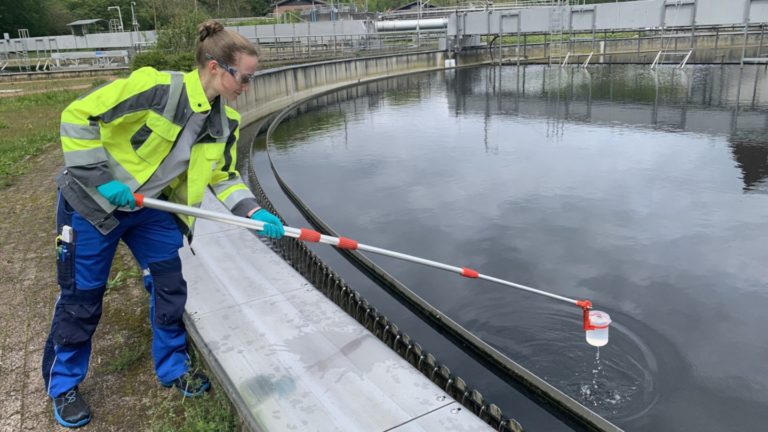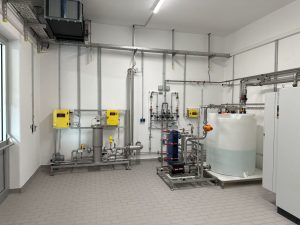Laser Immersion Probe for Smart Inline Monitoring of Water and Wastewater

The new inline measurement method is intended to supplement and in many cases replace random manual sampling, such as here at the Aachen Soers wastewater treatment plant of the Eifel-Rur Water Association. (Image source: Eifel-Rur Water Association (WVER))
The 2D fluorescence measurement method generates spectroscopic data directly on site in the clarifier. In conjunction with intelligent evaluation software, this process is the key to energy- and resource-efficient water treatment. It will be presented to the public for the first time at IFAT 2024, the world’s leading trade fair for water, sewage, waste and raw materials management in Munich.
In order to monitor water treatment processes in wastewater treatment plants, operators have so far relied on 24-hour composite samples. These are collected continuously throughout the day and then analyzed in the laboratory for sum parameters, such as the total amount of organic carbon (TOC), dissolved organic carbon (DOC) or the amount of oxygen consumed by the complete aerobic degradation of biological substances (biological oxygen demand; BOD). However, in view of the increasing population density in urban areas and varying wastewater compositions, this 24-hour grid is reaching its limits. Closer monitoring would not only be desirable with regard to the quality of treated wastewater. The need for energy and expensive operating materials, which are often harmful to the environment during production, could also be significantly reduced if operators could track how the measured values of the sum parameters change during the ongoing treatment process. Thus, they could control their plants based on this real-time data more efficiently.
Novel immersion probe detects emissions of fluorophores in wastewater
A research team at the Fraunhofer ILT is currently laying the technological foundations to make such data-based water treatment a reality. At the heart of this is a new type of laser-based immersion probe, which transfers water analysis from the laboratory directly into the clarifiers. “We use the phenomenon that substances relevant to water quality fluoresce when excited with specific wavelengths of light. Our immersion probe excites these fluorophores with different wavelengths between the UV and visible spectral range and detects the emitted fluorescence signals,“ explains Dr. Christoph Janzen, specialist in bioanalytics, who is responsible for the research project at Fraunhofer ILT. Targets for inline 2D fluorescence analysis include the amino acids tryptophan (TRP), tyrosine (TYR), phenylalanine (PHE) and the group of humic acids (HS). As the wavelengths for their excitation range from 260 nanometers for PHE to 350 nanometers for HS, the team couples the probe with a tunable light source. “This can excite all target substances with their specific wavelengths. If they are present in the wastewater, they emit their characteristic longer-wave fluorescence signal,“ he says. When a sensitive spectrometer is used, a fluorescence spectrum can be recorded for each excitation wavelength.
This results in 2D maps that record the excitation wavelengths together with the corresponding light emission. These so-called excitation-emission matrices visualize the detected fluorescence signals and provide operators with precise information about the organic pollution load in the wastewater at every stage of the treatment process. “This 2D fluorescence measurement makes it possible to record the characteristic sum parameters of the wastewater directly inline during the treatment process. To date, conventional processes can only do this offline in the laboratory. Commercially available inline probes for determining sum parameters are often only reliable in a limited parameter range and provide incorrect measurement data if the composition of the wastewater varies greatly,“ explains Janzen. To validate the measurements, it is also possible to record transmission spectra with the immersion probe in addition to the fluorescence data.
Sophisticated integration in a handy submersible probe
The project team has built on the extensive optical design and measurement technology expertise of the Fraunhofer ILT in order to implement the complex inline measurement process in the form of a handy immersion probe. Until now the measurements have usually been carried out offline in laboratory equipment. A laser-ignited xenon plasma lamp serves as the beam source as it has high brilliance and low heat loss. The desired wavelength is filtered from the light using a monochromator and transmitted to the immersion probe via an optical fiber. There it is collimated with a lens and focused on the measuring point by aspherical optics. The same optical system couples fluorescence signals of the sought-after substances via a second collimating lens into another fiber, which transmits them to a CCD-based spectrometer. Software developed by the team in a joint research project with partners from industry and research is used for evaluating and visualizing the measurement data.
The Aachen research team developed the probe itself in the EU-funded project “Fluo-Monitor - 2D fluorescence probe for inline water and wastewater monitoring“ with a medium-sized supplier of measurement technology, a water management research institute and a regional water board. The current BMBF-funded project AIX-Watch will continue to develop the 2D fluorescence measurement methodology and test it under real conditions. “The medium-term goal is to optimize the control and regulation of wastewater treatment plants using continuous inline measurements,“ says Janzen. Operators must check and document that their plant complies with the limit values for sum parameters such as TOC, DOC and BOD. The new 2D fluorescence process does not record these directly. However, the recorded amino and humic acids correlate with the sum parameters. “There are already mathematical models that deduce the values of the sum parameters from these correlations. If these models process continuously collected inline measurement data provided by our submersible probes, the accuracy of the analysis will continue to increase in the future,“ Janzen explains. This would give operators inline access to the status of their water treatment processes and enable them to adapt their operating strategies accordingly.
Smart, adaptive water treatment with AI and inline sensors
This would make the laser-based immersion probe the basic technology for smart water treatment. When it is combined with inline sensor technology and Artificial Intelligence, users could, despite fluctuating wastewater compositions, only use the amount of energy and expensive operating materials such as ozone actually required to comply with the legal limits. “As we are working with mathematical models here, we still need to back this up with conventional offline analyses,“ emphasizes Janzen. However, the learning models are a promising approach for adaptive wastewater treatment, which is based on inline measurements and orients its operating strategies to the actual state of the water and its current composition. In order to prepare the process for widespread use, the team at Fraunhofer ILT is continuing to develop the probe in parallel. According to Janzen, one approach is to use more cost-effective LEDs instead of the tunable xenon plasma light source. This is because in the context of data mining and AI, it is particularly important to expand the database quickly. More cost-effective immersion probes are one way to get closer to this goal.







